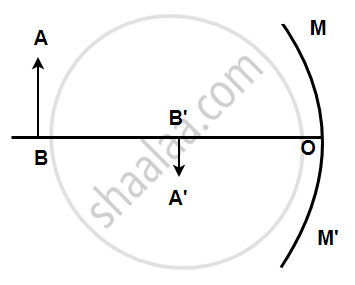Advertisements
Advertisements
प्रश्न
A small object is placed 150 mm away from a diverging lens of focal length 100 mm.
(i) Copy the figure below and draw rays to show how an image is formed by the lens.
Figure
(ii) Calculate the distance of the image from the lens by using the lens formula.
उत्तर
The image formed by the lens is virtual, erect and diminished in size.

(a)(ii) Object distance (u) = -150 mm = -15 cm (sign convention)
Focal length (f) = -100 mm = -10 cm (sign convention)
Image distance (v) = ?
Applying the lens formula, we have:
`1/v-1/u=1/f`
`1/v-1/-15=1/-10`
`1/v+1/15=-1/10`
`1/v=1/10-1/15`
`1/v=(-3-2)/30`
`1/v=(-5)/30`
`v=-6 cm `
APPEARS IN
संबंधित प्रश्न
Define the following term in the context of spherical mirrors:- Centre of curvature
Explain the following term related to spherical lenses:- aperture
We can obtain a real, enlarged and inverted image by a concave mirror.
State the direction of incident ray which after reflection from a spherical mirror gets reflected along its own path. Give a reason.
How is the focal length of a spherical mirror related to its radius of curvature?
Draw a ray diagram to show the formation of image of an object kept in front of a convex mirror. State three characteristics of the image.
The sun is seen before the sunrise and after the sunset.
AB is the object, A'B' is the image, and MM' is the position of the mirror. Complete the ray diagram showing the formation of the image and find the focal length of the mirror.

How tall does a mirror have to be to fit an entire person’s body?
